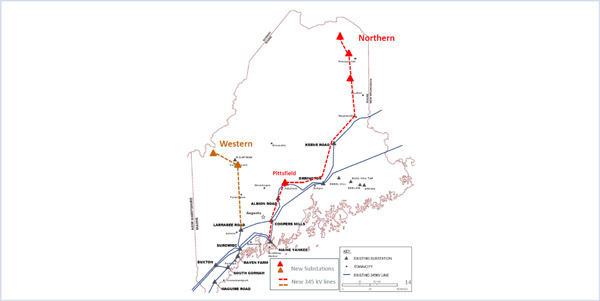By Rich Heidorn Jr. and Michael Kuser
ISO-NE hopes to open a window in November for Maine wind generators interested in joining a cluster interconnection system impact study. The RTO filed its proposed clustering methodology for FERC approval on Sept. 1, requesting approval by Nov. 1 (ER17-2421).
The filing culminates an 18-month effort to assess new 345-kV AC transmission circuits that could connect to areas in northern and western Maine with the largest number of requested new generation interconnections. (See ISO-NE to Offer Clustered Interconnection Requests in Maine.)
System Planning Director Al McBride presented a description of the filing and the study plans at Wednesday’s Planning Advisory Committee meeting.
The clustering approach will involve two phases: a regional planning study, followed by a cluster system impact study of multiple projects that will share the costs for common upgrades.
The Maine Resource Integration Study will be used as the regional study for the first two clusters being considered for development:
- A radial double-circuit 345-kV AC line between the Maine Yankee generating plant to a new substation at Pittsfield, with a new 345-kV line and three additional substations north of Pittsfield and ending near the Canada border. The estimated cost is $1.31 billion.
- A radial 345-kV AC line north of the Larrabee Road substation to near the New Hampshire border at an estimated cost of almost $521 million.
The estimates include a shared cost of $108 million for a new 345-kV line from Coopers Mills to Maine Yankee (line 392) that is needed by both radials. Costs would be allocated using the distribution factor methodology or the late-comer cost allocation rules.
The latecomer provision was developed to prevent free-riders with later interconnections from making use of the clustering upgrades. It would require interconnection customers that connect within 10 years of the cluster upgrade’s in-service date to share in the cost of the upgrades.
Planners estimate the combined clusters could accommodate about 1,900 MW of generation with a maximum of about 1,200 MW on either radial.
The northern cluster projects could accommodate up to 350 MW of additional generation without any new lines south of Pittsfield, assuming the Surowiec-South line remains at 1,600 MW. The maximum is limited by N-1 and N-1-1 violations on lines south from Orrington. Doing the project without the double circuit while increasing Surowiec-South to 2,200 MW would permit 675 MW in additional generation.
The clustering methodology received support from 95% of the Participants Committee in February.
Generators joining the study will be required to post a “very significant financial commitment” — the lesser of $1 million or 5% of the customer’s estimated costs for the upgrade, McBride said.
If either cluster is less than fully subscribed, the RTO will allow resources to withdraw to avoid a higher cost allocation.
“If the cluster doesn’t fill … we’re going to be continuing coming back to the PAC” for other solutions, including a potential HVDC project, said McBride.
The RTO also could open a second cluster window next year following the award of contracts in Massachusetts’ solicitation for 9.45 TWh a year of Class I renewables (wind, solar, hydro or energy storage). The winning projects are scheduled to be chosen by Jan. 25, with contracts completed and sent for state regulators’ review by April 25. (See Hydro-Québec Dominates Mass. Clean Energy Bids.)
McBride said ISO-NE doesn’t want to delay the first study window until after the solicitation because of the number of Maine wind generators ineligible for the cluster study whose interconnection costs might be affected by the cluster projects. “Their studies shouldn’t be held up any further,” he said.




